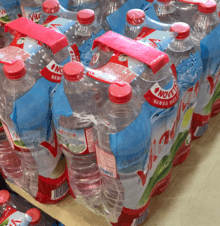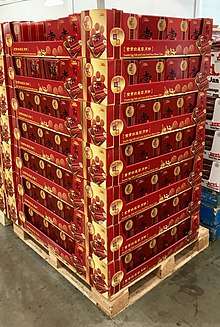Shelf-ready packaging


Shelf-ready packaging: SRP and Retail-ready packaging: RRP (also PAV: prêt-à-vendre) refer to the packaging of a product so that it is delivered to a retailer in packaging optimized for efficient stocking and sale.


Background
Retailers, particularly large Big-box stores, superstores, Warehouse clubs, sell large quantities of Fast-moving consumer goods. These retailers often want to have items shipped from their distribution centers to the stores in unit loads and bulk boxes: these can be stocked without handling of the merchandise. The goal for corrugated shipping containers is to put case goods directly onto shelves and stocking locations without individually handling the unit packs or primary packages. Retailers often require products to come in shelf ready packaging to reduce stocking costs and save labor expenses.
Ready-to-go Display stands and end caps are put in the retail sales location by Forklift trucks without assembly or manual handling of unit packs.[1] [2] [3]
Requirements
Retailers are commonly specifying all aspects of incoming logistics and packaging to their suppliers. This includes pallet size, bar code format and placement, rfid tags, strength of corrugated shipping containers, etc. Boxes must be easy to open and to prepare for stocking shelves. Several designs are available.[4] [5] [6] [7] [8] [9] [10] Box perforations, tear tape, etc must be intuitive and easy; box cutting knives are often discouraged. Frequently, requirements for reusable packaging and sustainable packaging are also provided.
The principles of shelf-ready-packaging are almost universal. Not all retailers, however, have the same detailed requirements. For example, Costcos “Structural Packaging Specifications”[11], Target’s “Shelf Ready and Transit Packaging Standards, Hardgoods”[12], and Walmarts "RRP and PDQ Display Standard Style Guide"[13] are similar but not identical.
Regional coordination in Europe has produced an agreement on common functional requirements for the design of SRP. The Efficient Consumer Response (ECR), Europe Working Group, has published “Shelf Ready Packaging” to help standardize programs. [14].
Manufacturers and packagers need to keep the diverse requirements of the retailers in mind as they package and ship their products. Sometimes consultants and contract packagers with experience in shelf-ready-packaging are useful.
Easy operations
Major retailers want their store operations to be “easy” and efficient. They put requirements on vendors or suppliers to deliver goods in packaging that make the retailer’s operations easy, Sometimes these are put in terms of five easies”. [15]
- 1 Easy Identification
Products must be clearly labeled by brand, name, stock keeping unit (SKU), etc. Bar codes and sometimes RFID tags must meet the retailer’s specification.
- 2 Easy Open
All SRP solutions should be easy to open, in order to secure easier and quicker replenishment. Packaging needs to be secure enough to withstand distribution but allow easy opening, preferably without special tools or knives. Opening processes should be intuitive; pictograms are useful.
- 3 Easy Recycle/dispose
In addition, a SRP should be easy to dispose or recycle. If the disposal of packaging materials is unwieldy and time-consuming, the benefit generated by SRP are negated by the disadvantages of elaborate disposal. Therefore, SRP should be disposable with little interaction, without assistance, space-saving, and foldable. When using re-usable SRP, clear instruction for its return are necessary.
- 4 Easy Shelf
Closely related to the functional requirement "easy open" is the requirement of "easy shelf". Both requirements are intended to facilitate the replenishment of the shelves. To ensure proper replenishment, the SRP needs to be stable and should not lose its original shape. Integrated package handles can facilitate the placing of goods on shelves. SRP should be stackable and stable so that the space available on one shelf can be used efficiently.
- 5 Easy Shop
Consumers must be able to easily identify and obtain the product they intend to purchase. SRP should improve product identification and thus make a positive contribution to the shopping experience. As a result, SRP should be designed brightly to attract the attention of customers. After removal of products, the SRP must nevertheless remain stable and still visually appealing for the customer when in a half-empty state.
SRP types
Due to the fact that there are many different products which need to be packed in a SRP, products can be delivered by a variety of solutions.
Shelf tray
SRP solutions which can be placed in the shelf are predominantly made of corrugated cardboard. In general, these consist of a tray (secondary packaging) and a cover (a lid which protects the product). The cover can be easily separated from the tray by a perforation.[16] Sometimes the cover of a tray is a transparent film which protects the products from mechanical and climatic influences. [17]
Re-usable plastic tray
In addition to SRP made of corrugated cardboard, SRP solutions can also be made of re-usable materials such as plastic. Such plastic containers can be re-used directly in the store. Furthermore, if re-use is not possible, the containers can be returned to the producer. [18]
Merchandising unit – promotional display, dolly, pallet / ½ pallet / ¼ pallet
Merchandising units represent another type of SRP solutions. They are used for secondary placement. Normally, promotional goods or fast-moving products are presented in a merchandising unit. An enormous number of products can be placed on a merchandising unit. Therefore, the merchandising unit serves as SRP.[19] Secondary placements can trigger impulse purchases. Often, roll-up palettes, called dollies, are used as a base for merchandising units. Rolling pallets facilitate the handling of merchandising units and increase flexibility. [20]
Importance of shelf-ready packaging from the perspective of traders
The implementation of SRP differs for discounters and full-line distributors. The implementation rate of full-line distributors averages about 37%, and is therefore considerably lower than the 90% implementation rate for discounters.[21] However, there are also differences among full-line distributors regarding the use of SRP. Basic causes are the respective strategies used in the markets. On the one side, some full-line distributors avoid the use of SRP for image-related and aesthetic reasons. On the other hand, some full-line distributors use SRP extensively because of the ease of handling and lower personnel costs. Apart from the strategy followed for individual markets, the decision whether to use SRP or not depends on the variety of goods provided in the market. The use of SRP in the discount trade has already been mentioned; cost savings can be realized while the best possible presentation of the products is possible. Thus, in some cases revenue could be increased up to 35%, partly because of the use of SRP.[22] In addition to the increase in revenue, SRP simplifies work processes and consequently increases productivity. Activities related to in-store logistics, such as storing, unpacking, labelling products and filling the shelves, account for 70% to 80% of the daily business in the food sector. It is clear that potential savings can be generated through the use of SRP.[23] Thanks to printing on the SRP, selecting stock becomes easier. Due to easier and faster replenishment, the largest potential savings result from this improvement to in-store logistics.[24] Depending on container size, 10 to 60 products can be displayed at once on a shelf.[25] To exploit the full potential savings of SRP, it may be removed from the shelf when the last article has been removed. This leads to gaps in the shelves that can affect the purchasing behaviour of customers. Through the use of an integrated product system, which pushes the remaining products to the front of the SRP whenever one product has been taken from it, shelf gaps can be reduced. [26]
See also
References
- ↑ US5850922A, Fraser, "Shipping and retail display pallet pack", published 1998
- ↑ US4919270A, Govang, "Pallet assembly for promotional display use and method of making same", published 1990
- ↑ US7131543B2, Mason, "Display device", published 2006
- ↑ US6073833A, Desrosiers, "Shelf ready shipping container", published 2000
- ↑ US5881884A, Podosek, "Shipping and display carton and blank therefor", published 1999
- ↑ US8342335B2, Couture, "Shelf-ready shipper display system", published 2013
- ↑ US20050184139A1, Couture, "Display-ready case", published 2005
- ↑ US6523692B2, Gregory, "Fold-in-half shipping/display box", published 2003
- ↑ US5372299A, Edgerton, "Combined product shipping and display box", published 1994
- ↑ US5657872A, Lefwich, "Shipping/display container", published 1997
- ↑ Structural Packaging Specifications (PDF), Costco, 2010, retrieved 24 August 2018
- ↑ Shelf Ready and Transit Packaging Standards, Target Australia, 2017, retrieved 24 August 2018
- ↑ RRP and PDQ Display Standard Style Guide (PDF), Walmart, 2016
- ↑ Shelf Ready Packaging (PDF), ECR Europe, 2016
- ↑ Blydenstein (2013). "Fast onto Shelf – Retail Ready Packaging and The 5 easies". Corrugated Coourse. Retrieved 1 October 2018.
- ↑ ECR Europe, GS1 Germany GmbH (2007) Handelsgerechte Regalverpackungen
- ↑ GS1 Germany (2008), Supply Chain Management
- ↑ ECR Europe, GS1 Germany GmbH (2007) Handelsgerechte Regalverpackungen
- ↑ ECR Europe, GS1 Germany GmbH (2007) Handelsgerechte Regalverpackungen
- ↑ o.V. (2008), Von Regaltray bis zu Logistikdisplays, In. Markenartikel
- ↑ Bergmann, H. (2007), Stand und Umsetzung von Shelf Ready Packaging
- ↑ Kober, I. (2006), Verpackugen: Fertig für's Regal
- ↑ Portmann, M. (2008), Sinnvoll und auch sparsam eingepackt
- ↑ o.V. (2008), Von Regaltrays bis zu Logistikdisplays
- ↑ Vollmers, F. (2007), Schicke Schachteln fürs Supermarktregal
- ↑ Portmann, M. (2008), Sinnvoll und auch sparsam eingepackt